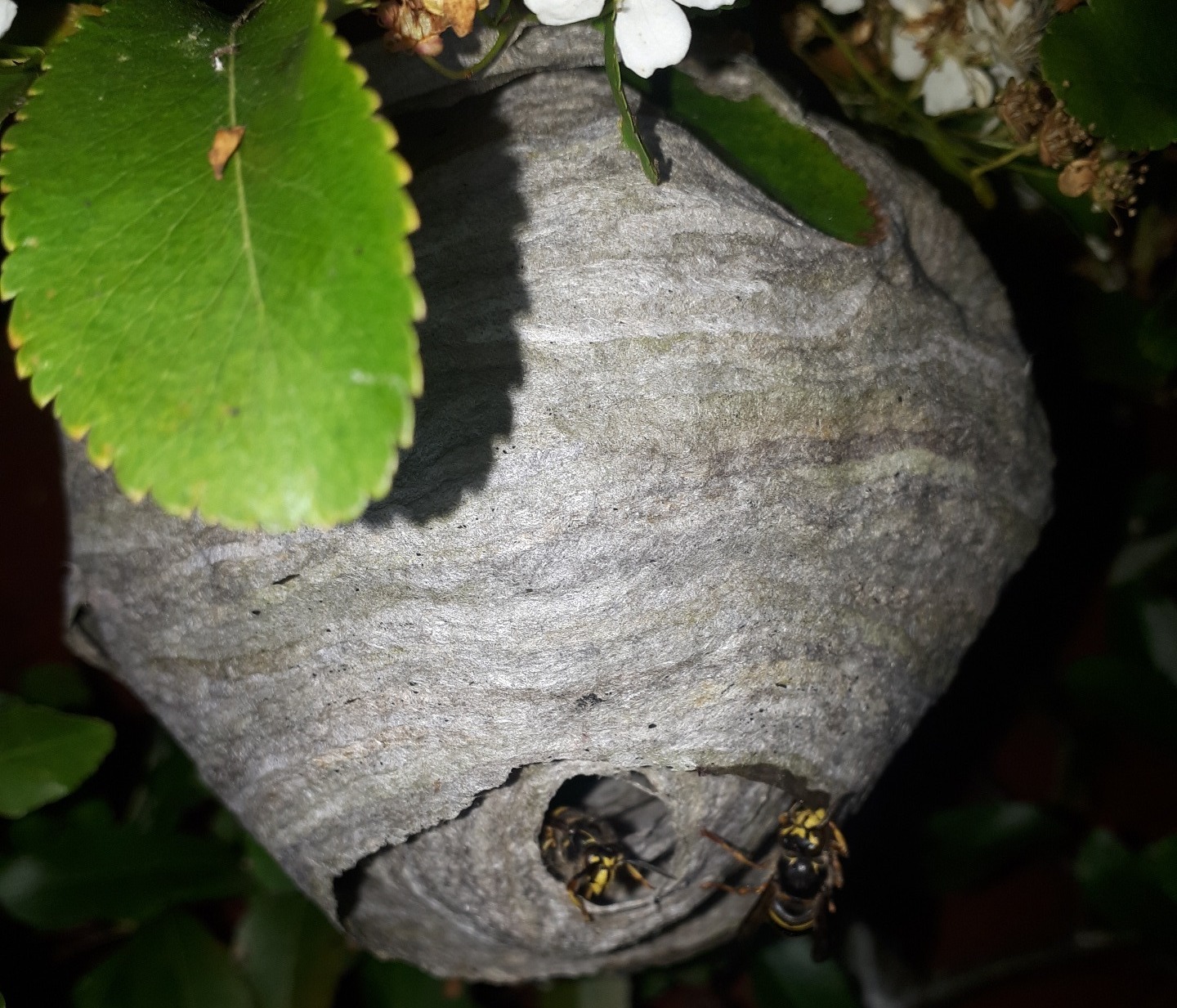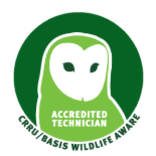The lifecycle of a wasp nest in Reading
Posted on 15th February 2020 at 08:33
Wasps and hornets are the one insect that almost everyone is afraid of and one we do our utmost to avoid, in the loft of many houses in Reading there will be the left over remains of a wasp nest or even, through the winter months and into spring, possibly a Queen wasp hibernating and waiting to emerge in the warmer weather.
Every year the cycle starts with an individual Queen wasp emerging from this hibernation period and starting a new cycle of life; she was fertilisied at the end of last summer and now she is ready to start her own colony. She starts by building a thick cylindrical column called a petiole that the nest will be suspended under, a single cell is created at the base of the stem and she then forms another six cells around, creating the characteristic hexagonal shape. The structure is encased is a paper ‘lantern’ that protects and stabilises the temperatures within.

The wasp nest is made from wood pulp: if you look at any weathered wooden structure such as fence panels and garden furniture you will notice ribbons of fresh wood showing through the older weather stained surface – this is the action of wasps stripping away the surface to make their nest. At this time of year, the Queen is busy building her nest, laying eggs, feeding herself and then feeding her brood.
Each brood cell is only ever used once, the Queen will build outer rings around the initial seven cells and at a certain stage, petioles will be added, reaching down and another layer of brood cells is added. This process is repeated, and the nest will go from the size of a ping pong ball to a beach ball through the summer. The outer paper sheath will thicken and tunnels through it will be added by the workers, these will be used to help regulate the temperature inside. If we experience a cold spell, the workers will close up the entrances and when we are in a heat wave they will stand in front of the opening using their wings to fan air around, keeping the nest cool – that’s the buzzing noise you can hear from the nest.
The Queen wasp is unique in that along with a sharp pair of outer mandibles, she also has teeth, so she is able to feed herself; the workers don’t possess teeth and are unable to feed themselves. This role is performed by the larvae in the nest who secrete a sticky sweet solution that the worker wasps suck up.
When you see wasps flying about in Reading what you are witnessing is, a highly synchronised operation where the workers are hunting for insects which they will bring back to the nest. These will be minced up by the workers who have the sharp outer mandibles – wasps can inflict a painful bite, the insects will be turned into a form of protein porridge and fed to the wasp larvae. In return the larvae will feed the wasps a sweet solution which the workers are able to suck up; the whole colony is highly orgainised with one aim: and that is to produce as many Queen wasps as possible come the end of the nests lifecycle.
More information on insect colonies and Eusociality can be found at the eLife website:

When you see a wasp nest in a house or hanging in shrubbery, do you know how many wasps can be in there?
Because there are 9 different species that form the traditional ‘wasp nest’ the numbers can change across the species: in general the earlier in the season the less the number. If you chance on an active wasp nest in the late summer be careful there could be thousands of wasps inside, and an accidental encounter could be very painful. The numbers inside can range from 600 up to between 3 and 5000; these wasps will all act aggressively to protect their nest so the best advice will always be to stay away and call on the services of a professional pest control company that are confident to carry out a wasp nest removal.
What is the difference between a wasp and a hornet?
The answer is not a great deal as these are from the same order of insects, aside from colouration and size the only noticeable difference is in behaviour. Hornets prefer to live in or near mature woodland, where you’ll find wasps in towns like Reading as there is an large insect population to feed off, hornets prefer rural areas.
In terms of numbers hornets will be much lower than the social wasps and they are less aggressive; don’t be fooled by that into thinking that they’re easy to eradicate; hornets carry 50mg of venom to the wasps tiny 15mg. Hornet venom also carries another chemical called hornet kinin that activates our pain receptors differently to wasps meaning a hornet sting will be more painful!
There is an invasive species of hornet called the Asian hornet which predates honey bees, as a single Asian hornet can decimate a full size bee colony in hours, these are a threat not only to the bees but also our food production – without honey bees there will be no so soft fruit.

As summer turns to autumn the aging Queen wasp will lay some male eggs amongst the last few batches; these are called drones and their function is to mate with newly hatched Queens from this and other colonies. Worker wasps within the nest will pack protein into the remaining larvae triggering an internal chemical response, the result of this reaction allows the eggs to pupate into young Queens. These Queens will mate with as many drones as they can, keeping a packet of sperm from each mating in their abdomen, this will be used to fertilise her eggs in the coming spring. Having a range of different donors means that the future colony has some diversity and a greater chance of producing healthy wasps, at this stage the old Queen is dying, her work is done and so for her the cycle ends.
This is now the worst time for wasp attacks; the Queen has died and with no eggs being produced. thousands of worker wasps are denied the ability to manipulate larvae for food, there are a few larvae left in the nest but not enough to feed the hordes of hungry worker wasps. Starving wasps will now be seen in Reading and the surrounding area, apparently randomly attacking people; these wasps are starving and they can pick up sweet tones from perfume or from sugary drinks and foods, they are not attacking us but rather pestering us to feed them. It is our fear and our negative relationship with the wasp that creates the illusion that they are attacking us.
With no food inside the nest to feed the workers they will abandon the nest in their search for food; remember that they are without teeth and the means to feed themselves? Wasps can suck up liquids and a potential source of food will be soft fruit like apples that have fallen from the tree, now bruised and leaking juice the wasps will flock to these to feed. If this juice ferments then its possible to see drunk wasps – aggressive, drunk wasps!

The young Queens will now do one of two things; they will either leave the nest to hunt insects and fatten up for the winter or they will stay put in their birth nest and wait for spring where the entire cycle begins again. You would think that having gone to all the effort in building the wasp nest that it would be re-used? Wasps never re-use their nest; they all start from scratch building that first petiole.
The year ends for our Queen, she will have produced thousands of sexless worker wasps who all sacrifice their future just to defend and feed her colony. Hundreds of Queens will emerge and if they can survive the winter then her offspring will in turn restart the whole process come the spring.
If you discover a wasp nest in Reading do not attempt to deal with it yourself and definitely do not try to seal up the opening hoping that you’ll trap them and starve them out; its easy for a wasp to gnaw through plasterboard and we have seen wasps nest grow through ceilings causing chaos inside the house. Here at Reading Pest Control we will have a technician out to you within 24 hours of your call and we will remove the wasp nest as part of our treatment leaving you completely pest free.
For more information on how we deal with wasps nest in Reading and the surrounding area - click on this link to take you to our main webpage on wasps and hornets.

FAQ’s
What is a wasp?
Wasps are nothing like bee’s; all insects belong to a family tree which is known as the Order, for wasps and hornets these belong to the order of Hymenoptera and therefore we should not confuse them with bee’s: honeybees, bumble bees and solitary bees like the masonry bee. There are two types of wasps the social wasp which we associate with the wasp nest, and this is the one that gives us the trouble. Solitary wasps known as parasitic wasps only target insects and they lay their eggs inside the living tissue of their prey, and as they do not have a nest to defend these are unaggressive and no threat to us.
What types of wasps do we have in the UK?
There are in fact 9000 species of wasps living in the UK and out of the 9000 only 9 species form colonies and these are the ones that we know cause the painful stings and present such a nuisance to us all through the summer months. The most commonly seen wasp is Vespula vulgaris – aptly named, the common wasp! The wasps that you’ll see flying back and forth are the worker wasps; all of which are female, and they measure from anywhere between 12 mm and 17 mm in length. The Queen wasp is slightly larger at 20 mm, its unlikely to see a Queen as they stay inside the nest once the workers emerge. The iconic yellow and black bandings warn animals that they are dangerous – incidentally, the masonry bee, which is without a stinger takes on the appearance of the common wasp for protection.
For more information visit the Countryfile website on the type of wasps that you’ll find in Reading – click on this link.
What use are wasps?
Contrary to popular belief that wasps are aggressive insects that just fly around and sting people they actually do a lot of good; wasps love sweet sugary liquids and they obtain nectar from flowers, pollinating as they go, it’s thought that they pollinate almost as much as honey bees do although this will be just for those flowers rich in nectar. Wasps are insectivores and so they eat hundreds and hundreds of insects, which is beneficial to us as these would ruin soft fruit crops. One important pollinator is the hoverfly and mimic hoverflies lay their eggs inside a wasp nest.
We don’t deal with hoverflies as these are not pests as they have an important role, to find out more visit the All About Hoverflies website: by clicking this link.
Share this post:












